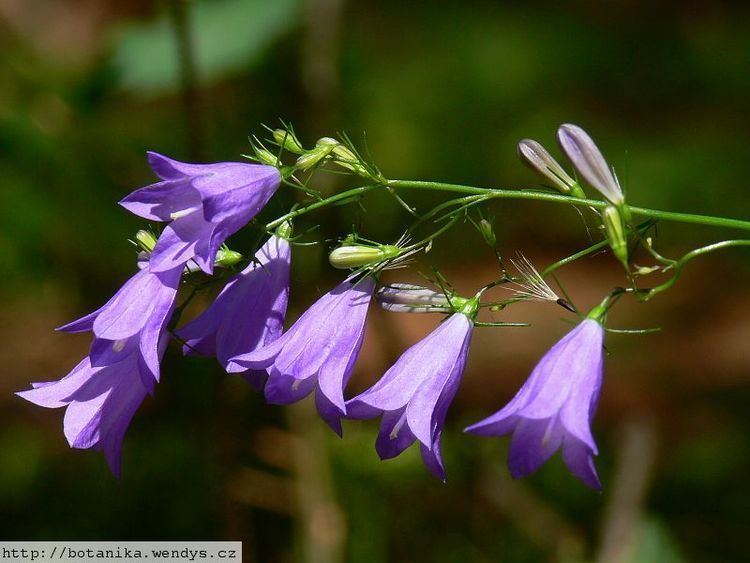Rank Species | Genus Campanula Higher classification Bellflowers | |
 | ||
Similar Nettle‑leaved Bellflower, Oxeye daisy, Cuckoo Flower, Cowslip, Marsh Marigold | ||
Bumblebee on campanula rotundifolia
Campanula rotundifolia (harebell) is a herbaceous perennial flowering plant in the bellflower family Campanulaceae. It has a circumpolar distribution in the Northern Hemisphere, from about latitude 40° N to about 70° N, extending in Europe from the north Mediterranean to the arctic.
Contents
- Bumblebee on campanula rotundifolia
- Common harebell campanula rotundifolia
- Description
- Distribution
- Habitat
- Adaptations
- Culture
- References
In Scotland, it is often known as the bluebell. Elsewhere in Britain, bluebell refers to Hyacinthoides non-scripta, and in North America, bluebell refers to Virginia bluebell. Campanula rotundifolia was historically also known by several other names including blawort, hair-bell, lady's thimble, witch's bells, and witch's thimbles.
Common harebell campanula rotundifolia
Description

Campanula rotundifolia is a perennial species of flowering plant, a slender, prostrate to erect herb, spreading by seed and rhizomes. The basal leaves are long-stalked, rounded to heart-shaped, usually slightly toothed, with prominent hydathodes, and often wither early. Leaves on the flowering stems are long and narrow and the upper ones are unstemmed. The inflorescence is a panicle or raceme, with 1 – many flowers borne on very slender pedicels. The flowers usually have five (occasionally 4, 6 or 7) pale to mid violet-blue petals fused together into a bell shape, about 12–30 mm (0.5–1.2 in) long and five long, pointed green sepals behind them. Plants with pale pink or white flowers may also occur. The petal lobes are triangular and curve outwards. The seeds are produced in a capsule about 3–4 mm (0.1–0.2 in) diameter and are released by pores at the base of the capsule. Seedlings are minute, but established plants can compete with tall grass. As with many other Campanulas, all parts of the plant exude white latex when injured or broken.

The flowering period is long, and varies by location. In the British Isles, harebell flowers from July to November. In Missouri, it flowers from May to August; in Minnesota, from June to October. The flowers are pollinated by bees, but can self-pollinate.
Distribution
Campanula rotundifolia has a near-circumpolar distribution in the northern hemisphere, from about latitude 40 oN to about 70 oN, extending in Europe from northernmost Scandinavia to the Pyrenees and the French Mediterranean coast. It occurs on the southern coasts of Greenland, on Iceland and Svalbard and on southern Novaya Zemlya.
It occurs as tetraploid or hexaploid populations in Britain and Ireland, but diploids occur widely in continental Europe. In Britain, the tetraploid population has an easterly distribution and the hexaploid population a westerly distribution, and very little mixing occurs at the range boundaries.
Habitat
Harebells are native to dry, nutrient-poor grassland and heaths in Britain, northern Europe, and North America. The plant often successfully colonises cracks in walls or cliff faces and dunes.
Adaptations
If exposed to moist cool conditions during the summer no pause in vegetative growth is exhibited, which suggests that temperature is a limiting factor. C. rotundifolia is more inclined to occupy climates that have an average temperature below 0 °C in the cold months and above 10 °C in the summer.
Culture
The harebell is dedicated to Saint Dominic.
In 2002 Plantlife named it the county flower of Yorkshire in the United Kingdom.
William Shakespeare makes a reference to 'the azured hare-bell' in Cymbeline
With fairest flowers,Whilst summer lasts, and I live here, Fidele,I'll sweeten thy sad grave: thou shalt not lackThe flower that's like thy face, pale primrose, norThe azured hare-bell, like thy veins; no, norThe leaf of eglantine, whom not to slander,Out-sweeten’d not thy breath.John Clare draws attention to the brightness of the flowers of the Harebell in the dark of the wood.
By the hare-bell 's hazure sky,(Like the hue of thy bright eye;)That grows in woods, and groves so fair,Where love I'd meet thee there.Christina Rossetti (1830–1894) wrote a poem entitled 'Hope is Like A Harebell'
Hope is like a harebell, trembling from its birth,Love is like a rose, the joy of all the earth,Faith is like a lily, lifted high and white,Love is like a lovely rose, the world’s delight.Harebells and sweet lilies show a thornless growth,But the rose with all its thorns excels them both.Emily Dickinson uses the harebell as an analogy for desire that grows cold once that which is cherished is attained.
Did the Harebell loose her girdleTo the lover BeeWould the Bee the Harebell hallowMuch as formerly?Did the paradise - persuadedYield her moat of pearlWould the Eden be an EdenOr the Earl -an Earl